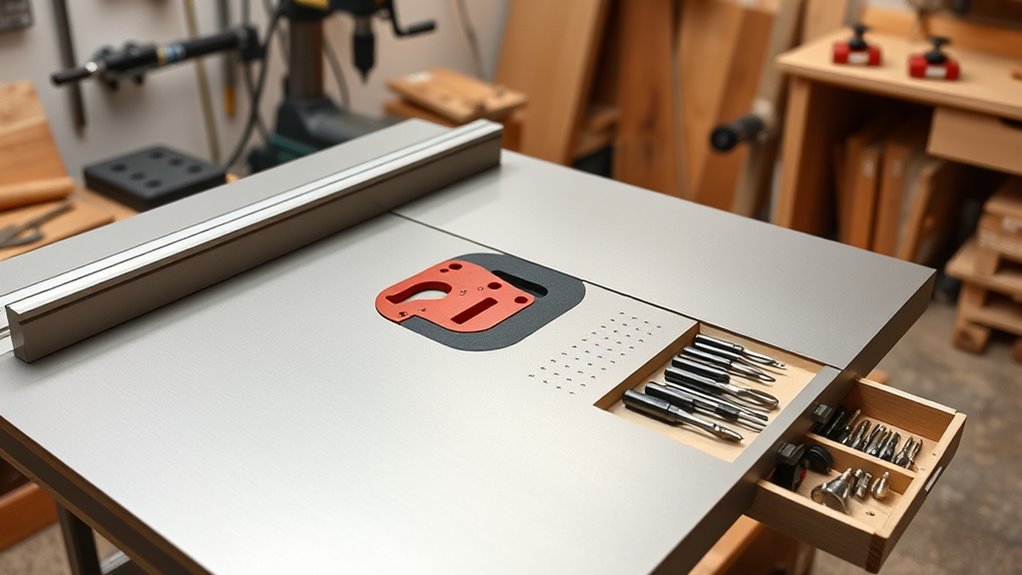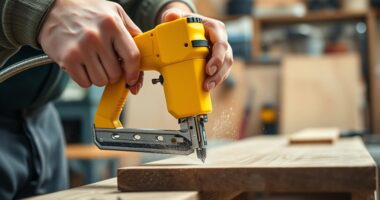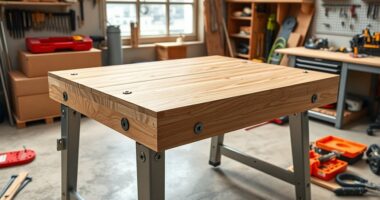When choosing a quality router table and accessories, focus on stability, build quality, and compatibility with your tools. Look for well-designed safety features like guards, anti-kickback pawls, and easy-access power switches to guarantee safe operation. Effective dust collection keeps your workspace clean and improves visibility. Investing in a sturdy table with versatile accessories not only enhances precision but also promotes safety. Keep exploring to discover how to pick the best options for your woodworking needs.
Key Takeaways
- Prioritize tables with built-in or compatible dust collection systems to maintain a clean and safe workspace.
- Choose models with robust safety features like guards, anti-kickback pawls, and secure fence systems for enhanced protection.
- Ensure the router table offers stability, minimal vibrations, and high build quality for precise and safe operation.
- Verify compatibility with a variety of router bits and accessories to maximize versatility and functionality.
- Select a table with accessible, easy-to-use power switches and emergency stop options for quick shutdowns and added safety.

Choosing a quality router table is vital for achieving precise and safe woodworking results. When you invest in a well-made router table, you’re setting yourself up for smoother cuts, better control, and a more enjoyable crafting experience. One of the most important aspects to consider is dust collection. A good router table should have an effective dust collection system that keeps your work area clean and free of debris. This not only improves visibility but also helps maintain a healthier workspace by reducing airborne dust particles. Look for tables with built-in dust ports or those compatible with shop vacuum systems. Proper dust collection also extends the life of your tools by preventing dust buildup that can interfere with their operation.
A quality router table with efficient dust collection enhances safety, visibility, and tool longevity.
Safety features are equally critical when selecting a router table. You want a table that prioritizes your safety without sacrificing ease of use. Features like safety guards, anti-kickback pawls, and secure fence systems help prevent accidents and give you confidence during operation. Many tables come with transparent guard shields that let you see your work clearly while protecting your hands from contact with blades or bits. Additionally, adjustable safety stops or lock mechanisms for fences are advantageous, allowing you to set precise cut depths while minimizing the risk of slipping or misalignment. Make sure that the table’s design promotes stability and minimizes vibrations, as wobbling or instability can increase the chance of mishaps.
Another safety consideration is the power switch placement. Opt for a router table with a conveniently located, easy-to-reach power switch that allows you to shut off the machine quickly if needed. Some models include emergency stop buttons or illuminated switches, giving you extra control at a moment’s notice. When you combine these safety features with proper operation techniques, you’ll greatly reduce the risk of injury or accidents. Remember, no matter how advanced your router table is, it’s essential to stay attentive and follow safety guidelines at all times. Additionally, investing in a router table with positive user feedback on durability and stability can provide added confidence in its long-term performance.
In addition to dust collection and safety features, consider the overall build quality and stability of the table. A sturdy, well-constructed router table will provide a solid platform, reducing vibrations and improving cut precision. Compatibility with various router bits and accessories also matters, so choose a model that offers versatility for your specific projects. Ultimately, selecting a router table with integrated dust collection and extensive safety features allows you to work efficiently, accurately, and safely—helping you produce professional-quality woodworking projects with confidence.
Frequently Asked Questions
What Safety Features Should I Look for in a Router Table?
You should look for safety features like dust collection systems to keep your workspace clear and prevent accidents. Anti-kickback mechanisms are essential to protect you from sudden machine movement. Make certain the router table has sturdy fences and secure clamps to hold your workpiece firmly. Additionally, safety guards and easy access to power controls help prevent injuries. Prioritizing these features ensures safer and more efficient routing sessions.
How Do I Choose the Right Fence System for My Router Table?
Choosing the right fence system means balancing precision and durability. You want a fence that’s easy to adjust, with smooth fence adjustment mechanisms, and made from sturdy fence material like aluminum or steel to withstand wear. Consider fences with clear, easy-to-read measurement scales for accuracy. A versatile fence system allows for fine-tuned adjustments, ensuring your cuts are precise. Don’t settle for less—select a fence that enhances safety and consistency in your woodworking projects.
Are There Specific Accessories Recommended for Beginner Woodworkers?
As a beginner, you should look for accessories like a router lift to improve precision and safety, and a dust collection system to keep your workspace clean. These tools help you achieve better cuts and maintain your equipment. Adding a dust port to your router table minimizes dust buildup, while a router lift allows easy bit changes and height adjustments. Both accessories make your woodworking safer and more efficient.
How Do I Maintain and Clean My Router Table and Accessories?
Maintaining your router table is like tending a garden—you need regular care. Clean dust collection systems after each use to prevent buildup, and check for loose parts. Sharpen your router bits periodically to guarantee smooth cuts. Wipe down the surface with a damp cloth and avoid harsh chemicals. By staying proactive with dust collection maintenance and router bit sharpening, you keep your table in top shape, making every project easier and safer.
What Are the Best Storage Solutions for Router Table Accessories?
You should use dedicated storage solutions like labeled bins or drawers to keep router table accessories organized. Incorporate dust collection systems to prevent debris buildup, and use adjustable workpiece supports to make your workspace safer and more efficient. Wall-mounted racks or pegboards work well for quick access, while clear containers help you identify parts easily. These solutions keep your accessories tidy, accessible, and protected, enhancing your overall woodworking experience.
Conclusion
Choosing the right router table and accessories guarantees your projects turn out precise and professional. While it might seem tempting to cut costs with cheaper options, investing in quality assures durability and better performance over time. Remember, a reliable setup saves you frustration and money in the long run. Don’t compromise on safety or quality—your craftsmanship deserves the best tools to bring your vision to life effortlessly.









